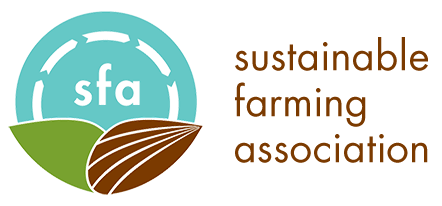Meet the Regenerative Grazier: Tyler Carlson
This interview with Tyler Carlson originally appeared in the Silvopasture Learning Network’s first e-newsletter. The Silvopasture Learning Network is a project to research effective silvopasture practices and innovations, and educate farmers, agricultural and natural resource professionals and conservationists throughout the state on silvopasture and oak savanna restoration principles and practices. SLN is a partnership among SFA, University of MN Extension, and Great River Greening. Learn more on SLN’s website, Facebook, or by joining the email list. You can also see SFA’s upcoming Silvopasture events on this page.
 Meet the Regenerative Grazier
Meet the Regenerative Grazier
Tyler Carlson is the Silvopasture & Agroforestry Project Lead for the Sustainable Farming Association of Minnesota. In this interview, learn how he became interested in silvopasture, why he’s passionate about it, and how he advises newcomers to the practice.
How did you become interested in silvopasture?
In 2008 I completed a permaculture design course that introduced me to the concepts of complex polycultures and mimicking natural systems in human food production. In my studies at the University of Minnesota I took a course on agroforestry which included silvopasture.
Agroforestry and especially silvopasture combined my interests in sustainable agriculture, restoration ecology, and livestock and large herbivore impact on ecosystem form and function. I knew pretty quickly that this was something I wanted to experiment with on my own farm.
How did you become involved in the Silvopasture Learning Network?
In January 2020 I was contracted by the Sustainable Farming Association to lead the organization’s efforts on Silvopasture training and adoption in Minnesota. One of the key elements of my work is to help bring together a diverse group of farmers, resource managers, foresters, and ecologists to create a community of practice to advance the knowledge of, increase adoption of, and improve the outcomes of silvopasture in Minnesota. This is the Silvopasture Learning Network.
What makes you passionate about silvopasture?
The hopeful promise of grass-based livestock agriculture is that we can restore grazing animals to their appropriate ecological context, improve grassland plant diversity, wildlife and pollinator habitat, stop erosion and build soil, infiltrate and store water, and sequester excess carbon in the soil. All of this can be part of our food system, not just separate from it.
Silvopasture takes the power of diversity and adaptively-managed livestock impact to the next level by directing it toward the restoration of savanna and woodlands. Silvopasture has the potential to sequester enormous amounts of carbon while improving the form and function of the landscape. The prospect of sequestering carbon, restoring oak-savanna and oak-woodland habitat, and creating an attractive, comfortable environment for livestock, wildlife, and humans while generating income is very attractive.
I am also passionate about silvopasture because of the community of interest in it. The diversity of species, habitats, ecosystem services, and human uses associated with the savanna seems to attract a similar diversity of people to our events. Farmers, hunters, ecologists, resource professionals and government agencies, foragers, birders, nature lovers, and consumers are all turning out to learn and contribute. Silvopasture has something for everyone.
What can modern producers learn from indigenous silvopastoral practices?
Minnesota’s landscape prior to European settlement was probably more heavily influenced by indigenous Americans than many prior ecological histories have suggested. I think there is a general, over-simplified narrative that the tall-grass prairie and oak savannas were formed by the grazing impact of the bison and random acts of fire set by lightning and that their distribution was determined by climate, soil, aspect, etc. This narrative ignores what was likely an intentional, targeted use of fire by indigenous peoples to direct and attract large and small game, create highly diverse habitat for roots, nuts, leaves, and fruit for harvesting, and create a generally comfortable landscape with sufficient shade and ease of movement and defense.
Fire can serve as a tool to stress and eliminate shrub and tree saplings, and the lush green-up of the grasses and forbs following burns would have attracted many large herbivores to the area who then provide a follow-up impact on any surviving brush and sapling trees through grazing and trampling.
If we overlook how indigenous peoples and practices shaped and maintained our ecosystems, any efforts to conserve and restore native landscapes will fall short. We can’t simply reestablish native plant communities without accounting for the historical disturbance regimes that they evolved with, including a sometimes heavy human hand. Today, of course, the large, roaming, wild herds of bison and elk, and the extinct megafauna are gone. And extensive use of fire on the current, highly-developed landscape of Minnesota is unlikely and climate imperatives present a new reality where fire may be counter to the need to sequester carbon.
So we need to find new ways to manage livestock impact and other tools of disturbance to restore some of this form and function to the landscape. Will we perfectly re-create the vast prairies and savannas and woodlands that were here hundreds of years ago? Probably not. But I think we can create something similar and perhaps just as resilient and beautiful. Something that can restore humanity’s connection to the earth’s ecosystems as a generative force and restore our relationship to livestock as sacred partners in our co-creation of a just and habitable world, instead of casting them as a burden in a changing climate or a technology to exploit.
What advice would you give to producers considering silvopasture?
Start small and adapt as you go. Learn to manage livestock adaptively with modern fencing equipment first and then start introducing them to your wooded areas a little at a time. Learn to observe the impacts. Do more of what works and adapt to what doesn’t. Be creative. No one is a master on this, yet, and everyone’s experience will contribute greatly to our collective advancement in this area. Oh, and take pictures and share your insights by joining the Silvopasture Learning Network!
